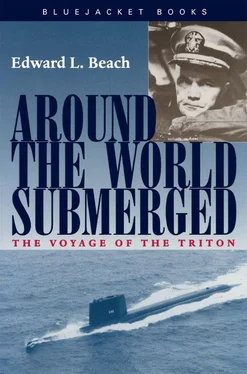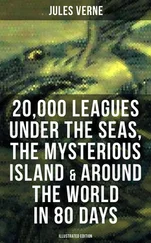From the Log:
During the approach to Guam, we have remained at periscope depth and have observed considerable activity on shore. Several aircraft are landing or taking off and a helicopter can be seen hovering over the airfield. We can see the planes being maneuvered about the hangar and people walking on the roads, cars driving back and forth, and other signs of activity. There is one housing area which is very clear indeed on top of a near hill with slope toward the sea. We can see the green grass plots, and brown areas where walkways and driveways have been carved out. The houses are white or creamed stucco, surrounded in most cases by flowers and shrubs.
As we prepare for our reconnaissance our vision is occasionally obscured by a succession of torrential downpours which come marching in from the north. At times the rain is so heavy that it is impossible to see more than a few hundred yards in any direction. Our photographic efforts therefore are under an unusual difficulty—that of predicting the showers so that the part of the island we wish to photograph is for the time being clear. During one period there were as many as three localized thunderstorms on different bearings, with clear visibility between.
Today is a big day, too, for Edward C. Carbullido, SD2 (SS), USN. Carbullido was born on Guam and has youthful memories of the period of Japanese occupation during the war. Subsequently, when old enough, he enlisted in the US Navy and has been in the Navy for 14 years, during which he has never returned to his home island. Today is, in fact, the closest he has ever been. We wish it were possible to let him go ashore for a few days, and we shall do as much as we can for him.
Carbullido’s father is a Chief Quartermaster in the Navy, now retired and living here. He has recently built a new home in the town of Agat, just to the southward of Orote peninsula, around the point of land from Apra Harbor and Agana, the main city of Guam.
Many a father would like to have a son like our Carbullido. During the Japanese Occupation, the father was away. This was good luck, of a sort, but during this period there was no support for his family. Edward Carbullido, the oldest, worked for the Japanese to support his mother and the younger children. After the war, as soon as old enough, he joined the Navy, and during the subsequent 14 years he has sent home every cent he could spare, a total of several thousand dollars, to help pay for a new house and the education of his brothers and sisters. Carbullido’s ambition is to return to Guam after completing 20 years of service, 6 years from now. One can hardly believe that he is actually well into his 30’s; he looks 10 years younger.
We spread a map of Guam on the wardroom table and ask Carbullido to pinpoint, as accurately as he can, the exact spot where his parents’ house is. In “The Skipper’s Corner” I have explained that today, after we have carried out our scheduled drill photographing the Island of Guam, we shall expend a few hours giving Carbullido the best possible look we can through the periscope at his home town. This seems to suit everyone.
After we finish photographing the town of Agana, we go through the same procedure at Apra Harbor. Behind the breakwater we can see a floating dry dock, a Navy barracks ship or barge, and what looks like a small seaplane tender. We then pass close around the tip of Orote peninsula, periscope raised, looking very carefully at the signal station out on the end of the point. We don’t want to be detected; therefore it receives a searching investigation. The place is deserted.
1445 We have rounded Orote Point and changed course toward Agat. The water is deep and the sea calm, although large rollers are sweeping down past Orote Point. They do not affect us in the lee of the land.
Carbullido is ready a full hour early in the Conning Tower, wearing a clean suit of dungarees and grinning self-consciously. As we approach Agat, he gets his turn with the periscope alternately with the Executive Officer and myself. His eagerness is evident as we approach closer and closer, and the objects on shore become clearer to him.
During our times at the periscope Will Adams takes navigational cuts, and I am constantly sweeping the near shore against any possibility that someone might be there by chance looking out to seaward. People ashore rarely look to sea, however, and I doubt, even if there were anyone, that there would be much chance of their seeing our periscope. Nevertheless, we are cautious with it, exposing only a few inches for brief seconds.
It is touching to see the intense eagerness with which Carbullido peers through the periscope, looking for the house he has helped to buy but has never seen. With a big grin, he announces that Agat is very different from the way he remembers it. “Many more people,” he says, “many more houses.” It is, indeed, an attractive modern-looking town. As we draw closer, we insist upon Carbullido identifying his father’s house, which he feels he can do from the descriptions and pictures he has received by mail. Finally, with a wide smile, he has it spotted, and we all eagerly take turns to look it over. Even with the periscope at high power and the ship as close to shore as we can bring her, the house Carbullido has selected is only a tiny spot in the distance. It is situated as he had described it, on a fairly high piece of ground, near the water but high enough to be free of flooding.
We stay a long time at slow speed in Agat Bay, in order to give Carbullido the maximum periscope liberty possible. At one time I draw Carbullido to the periscope with the idea that I can see a person or people near his house. After a long look Carbullido confirms this, but still I am not sure. It would be nice to say that he actually did see some member of his family, but we are too far away to be positive. Whatever it is I saw, it was motionless much too long.
1630 We have been in Agat Bay an hour and ten minutes; it is time to go. Regretfully, I tell Carbullido that we must put the periscope down and get under way for the Philippine Islands. Carbullido’s eyes are shining as he thanks everyone in the conning tower and starts down the ladder into the control room.
One of the things which has impressed me from the beginning of this episode is the consideration and kindness of the rest of the crew and the conning tower personnel for their shipmate. So far, at every landfall we have made, there has always been a number of men wanting to come up for a look; off Cape Horn and Easter Island there had been a determined effort to get as many people as possible to the periscopes so that they could say that they had seen them. In this instance, not a soul has asked for permission to come up and take any of Carbullido’s periscope time; and if he had been the Captain of the ship himself, he could not have received more attention or assistance from the quartermasters with regard to focusing the periscope, aiming it in the right direction, setting his bearings, etc. As Carbullido’s grateful face vanishes below the conning tower hatch to the control room, Chief Quartermaster Bill Marshall puts into words the thought which has occurred to all of us: “Wouldn’t it be great if we could figure out some way to get him to Guam for a real leave? Fourteen years away from home is a long time.” We have already been gone a long time, too; a month and a half. To Marshall’s words, there is general nodding assent.
A few hours later, I went Marshall one better and categorically promised Carbullido that some way, somehow, we would get him to Guam. It was a reckless promise, but I felt a way would turn up to make it good.
So far as we could tell, we had passed close aboard the island of Guam, had held the periscope up for a lengthy period, and had even spent considerable time in Agat harbor with the periscope going up and down almost continuously without stirring any noticeable reaction on shore. That night, however, I suddenly was not so sure. We had been at periscope depth for a short time, to make our normal celestial observations and ventilate the ship, when flashing red and green lights were detected on a bearing northeast by east, in the general direction of Guam, approximate altitude 30°, closing on us with a steady bearing.
Читать дальше












